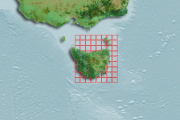Gonad weight
Type of resources
Topics
Keywords
Contact for the resource
Provided by
Years
-

Adult reproductive data for redbait is based on collections taken by midwater trawling during the spawning season and includes the biological information - size, sex, reproductive condition (weight and stage). Histological examination of mature ovaries provides information on spawing activity and preserved gonads are examined to determine batch fecundity.
-
Sampling of commercial mid-water trawl catches for small pelagics from waters adjacent to Tasmania have yielded an extensive biological dataset in space and time. As a minimum, size composition information is available from most commerical shots undertaken between 2002 and 2006, referenced with operational information (location, depth and catch weight). Subsamples of the key small pelagics, redbait, jack mackerel and blue mackerel, were examined for size, sex, gonad weight and stage and otoliths have been retained for age determination. Further data has been collected since the initial investigation.
-
Recent poleward range expansion of the barrens-forming sea urchin Centrostephanus rodgersii (Diadematidae) from mainland Australia to Tasmania, has emphasized the need to understand the population dynamics of this ecologically important species in Tasmania. This work informs potential population dynamics of C. rodgersii in Tasmania by examination of its reproductive ecology. Reproductive periodicity (gonad index and propensity to spawn) was assessed bimonthly for 18 months at 4 sites in eastern Tasmania. Gamete viability was assessed by fertilization and early development trials. Temperature tolerance of Tasmanian C. rodgersii larvae was also assessed to determine whether this species has undergone an adaptive shift to the cooler Tasmanian environment. There was also no evidence for an adaptive shift in reproductive phenology. Reproductive phenology was assessed by determination of peak spawning period (gonad index analysis).
 IMAS Metadata Catalogue
IMAS Metadata Catalogue